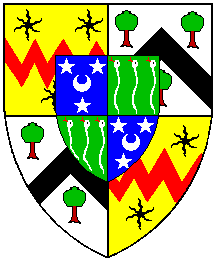
Back to the APL-385 Home Page
Visit the Heraldry of Gilling Castle

Stonegrave is a small village near Helmsley in North Yorkshire (the North Riding for die-hard traditionalists!). The church, commonly known as Stonegrave Minster, is interesting, dating back to Saxon times. It has many treasures including a magnificent carved stone cross of probable 9th century date.
My interest is in the heraldry, and recently I helped my father with a survey of the various achievements in the church.

The arms above are from one of the wall monuments, and show Comber quartered with Thornton, overlain by a shield of pretence of Arbuthnot quartering Hassell. The blazons are given below if you are interested!
There are four main groups of heraldic interest:

Most of the heraldic information is taken from Papworth.
Much of what follows is by my father P.R.O. Wood.
Two special features must be mentioned, both concerned with the generations. The first is “showing off”. When a man has many titles, he will have the right to display many different coats. This quickly becomes self-defeating on a shield, so the display is packed together in a series of rectangles. This is what has happened high up on the south wall of the Choir [the Thornton achievement]. We have identified some but by no means all of the families. The problem is magnified by the difficulty in reading the colours.
 The second is a statement of intent; If a man marries above his station, he will display his wife’s coat as a small shield on top of his own. This occurs at Stonegrave in three impressive and very similar [Comber] monuments, one on the north wall of the choir, and two on the west wall. Those on the west wall show the arms of Wilson (left) on one of the quarterings of the main shield.
The second is a statement of intent; If a man marries above his station, he will display his wife’s coat as a small shield on top of his own. This occurs at Stonegrave in three impressive and very similar [Comber] monuments, one on the north wall of the choir, and two on the west wall. Those on the west wall show the arms of Wilson (left) on one of the quarterings of the main shield.
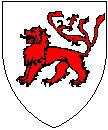 Early
drawings like the strange creature in the small frame on the north wall occur
in early heraldic rolls; it is suggested that the artist is trying to draw an
animal which he has never seen. We might blazon
it as Arg. a lion statant Gu. This could be for Clare, Clarke, Petit
or Quesnes, but does not appear to be for de Stonegrave as suggested (at least
according to Papworth – but see below).
Early
drawings like the strange creature in the small frame on the north wall occur
in early heraldic rolls; it is suggested that the artist is trying to draw an
animal which he has never seen. We might blazon
it as Arg. a lion statant Gu. This could be for Clare, Clarke, Petit
or Quesnes, but does not appear to be for de Stonegrave as suggested (at least
according to Papworth – but see below).
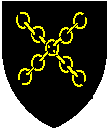 An early history is suggested by the little framed cards, and the two tombs [only one has a recognisable shield], on the wall of the north aisle. I can find no trace of [arms for] St. Leonard, but it was common to invent arms for the early saints. Note that St. Leonard is the patron of prisoners, presumably hence the broken chains in the ‘attributed’ arms sable 2 [broken-ended] chains in saltire or [The picture is dark and the colours unclear; one of the chains could well be argent].
An early history is suggested by the little framed cards, and the two tombs [only one has a recognisable shield], on the wall of the north aisle. I can find no trace of [arms for] St. Leonard, but it was common to invent arms for the early saints. Note that St. Leonard is the patron of prisoners, presumably hence the broken chains in the ‘attributed’ arms sable 2 [broken-ended] chains in saltire or [The picture is dark and the colours unclear; one of the chains could well be argent].
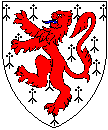 I have not found any Arms for Stonegrave. The single tomb is said to be that of Sir John Stonegrave [another stone effigy, probably from the 13th century].
I have not found any Arms for Stonegrave. The single tomb is said to be that of Sir John Stonegrave [another stone effigy, probably from the 13th century].
[Further research suggests that Sir John died in 1295, and bore the arms ermine a lion rampant gules ]
Thornton effigy
The shield at his side tells us that the couple remembered in the other one, are Thorntons.  At this stage the thorn trees we find in later arms are sprigs.
The later arms which occur in several places have complete trees.
At this stage the thorn trees we find in later arms are sprigs.
The later arms which occur in several places have complete trees.
The Thorntons are said to have lived at East Newton [a manor very close to Stonegrave] for many years, and the arms also occur in the nice coloured window at the east end of the south aisle (along with those of Wandesford – see below under the Thornton achievement).
Combers
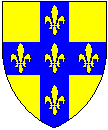
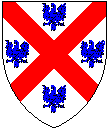 The other important family are the Combers. There are several Comber monuments in the church. There is also a considerable amount of information on their family tree, which I have not included here. The little brass in the Sanctuary tells of their arrival in Stonegrave. It shows that a maiden lady called Mary Burton (daughter of Bryan Burton of Kent – shield left) married firstly into the Hamden family (m. Edward Hamden – shield right) and later married James Comber.
The other important family are the Combers. There are several Comber monuments in the church. There is also a considerable amount of information on their family tree, which I have not included here. The little brass in the Sanctuary tells of their arrival in Stonegrave. It shows that a maiden lady called Mary Burton (daughter of Bryan Burton of Kent – shield left) married firstly into the Hamden family (m. Edward Hamden – shield right) and later married James Comber.
Their son Thomas was Rector of Stonegrave and a Dean of Durham. He is commemorated on the impressive engraved slate slab, at the entrance to the choir. This is the man who ‘addressed a crowded Minster in York, on the accession of William and Mary.’ (Arthur Mee).
The Combers and Thorntons are linked by marriage, so the Thornton arms also appear on the Comber monuments (as, for instance in the large shield above).

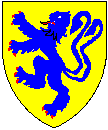





This is in memory of William Thornton of East Newton, erected by his wife, Alice Wandesford. He died in 1668. Their eldest daughter Alice married Thomas Comber. This is why the Comber and Thornton arms are quartered on the monuments.
William Thornton was the son of Robert Thornton and Elizabeth, daughter of Robert Darley of Audby. Alice Wandesford was the daughter of Christopher Wandesford of Kirklington and Alice, daughter of Sir Hewitt Osbourn of Kiverton.
The achievement is very complex, with twelve sections representing 12 families linked by marriage. The colours are not easy to distinguish, which makes the identification of some of the arms very difficult – so the attributions should be regarded as suggestions only. The 12 sections probably represent 6 each for Thornton and Wandesford [parted per pale, i.e. vertically, as usual for husband and wife]. There are two crests, and two mottos, one for each family. The Thornton crest is a lion’s head (?sable) issuing from a ducal coronet; the motto is Nisi Christis Nemo. [Steven Bramlett has recently sent me a copy of a grant of arms for a crest to Robert Thornton of East Newton, dated 1563, which gives “on a torse argent and sable a lion’s head razed purple, about his neck a crown argent”.] The Wandesford crest is a church proper, the spire azure; motto Tout pour l’Eglise.
The shield is shown below, with the 12 individual sections blazoned underneath.
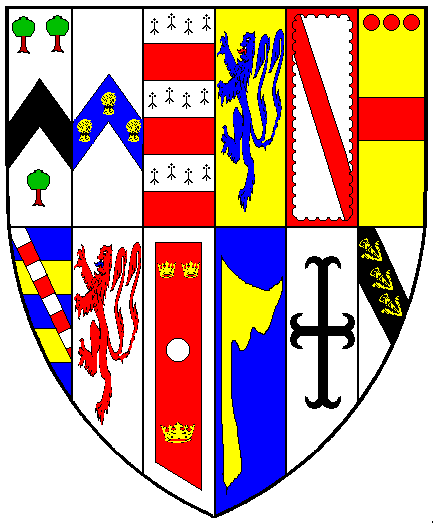
The diagram identifies the arms, which are blazoned below.
The Thornton half of the arms is as follows:
The Wandesford half of the arms is as follows:
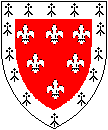 |
Note that none of the above are for either Darley Gules 6 fleur-de-lys 3, 2 and 1 argent, a bordure ermine (left) or Osbourn quarterly ermine and azure, on a cross or 5 pellets (right). | 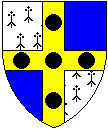 |
Notes: Alice Thornton was the daughter and heiress of the William Thornton of the achievement. What happened to the sons and other daughters? She married Thomas Comber the Rector (& Dean of Durham). In 2001 I was sent details of her family by Rose Comber, a descendant.
The Comber crest is variously a lynx’s or a greyhound’s head, either gold with 3 pellets (or pelletty), or sable with 3 bezants. The arms granted in 1571 to John Comber of Shermanbury, Sussex have the lynx pelletty.
The brass shows coats related to Mary Burton who married James Comber.
 The window [in the south aisle] has Thornton and Wandesford arms, presumably for William Thornton and Alice Wandesley (right).
The window [in the south aisle] has Thornton and Wandesford arms, presumably for William Thornton and Alice Wandesley (right).
The Achievement is for William Thornton/Alice Wandesford. Note the number of ?Leigh arms. The monuments show Comber quartered with Thornton, with Arbuthnot quartering Hassell as a shield of pretence. The two on the west wall have Wilson replacing one of the Thornton quarters (the 3rd).
Note the early Thornton arms have thorn sprigs not trees. Papworth gives “Thornton of Estnenton” as Argent a chevron sable between 3 hawthorn leaves vert. Estnenton might well be a mistake for East Newton.
The “Stonegrave” shield, shown as argent a lion statant (with a fancy tail) gules is not in Papworth. Arg. a lion passant gu. is Clare, Clarke, Petit or Quesnes. I now know (thanks to Irene Szymanski) that the correct Stonegrave arms are Ermine a lion rampant gules as shown above.
The shield attributed to St. Leonard I cannot find.
© Gill Smith 1998-2000
Please email Gill Smith with your comments.
Interested in more Heraldry? Try the Heraldry of Gilling Castle pages...
© Gill Smith 1998-20`9
Page maintained by APL-385. Back to the Home Page